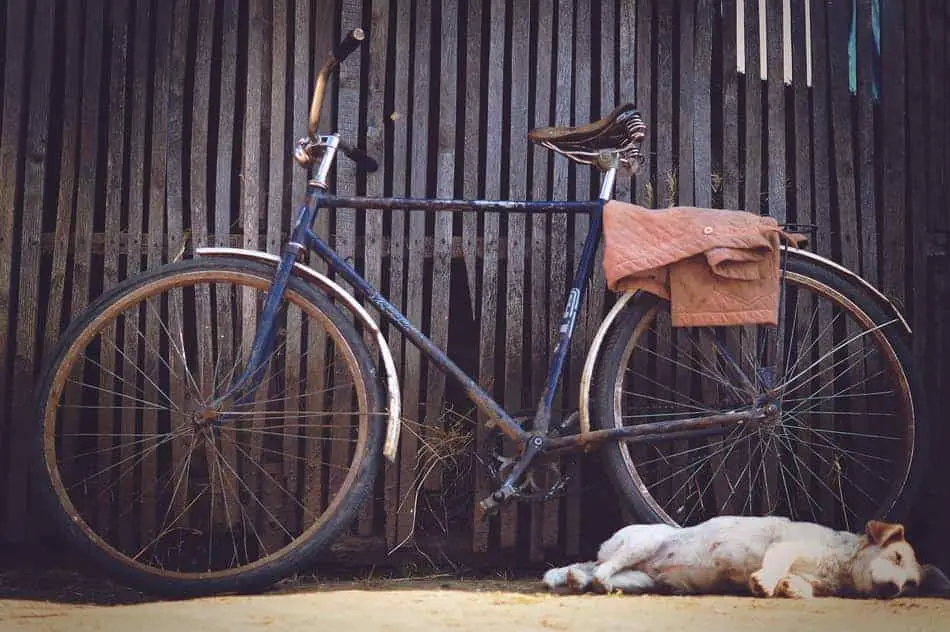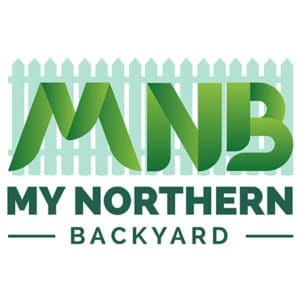
We had a problem last winter. Although we’ve got a two car garage, we actually wanted to store both cars there. We live where there is most definitely snow, and a garage is not a luxury that we want to pass up. This is not the kind of two car garage where you can also throw in a refrigerator, your grill, a tool bench, and, well, bicycles at the back of the garage and still fit the cars. With 5 bikes to store there isn’t enough ceiling space to get them all up there and so I wondered – can I safely store our bikes in the backyard? I went looking around and here’s what I found.
Can you store your bike in the backyard? Yes, definitely, but you need to consider how you will protect your bike both from the elements and from theft before choosing to store your bicycle outdoors.
This is definitely something I wanted to explore. Many people don’t have the space in their garage, or even have a garage, to store bikes summer or winter. Storing you bike in the backyard can be a great solution with the proper preparation.
Your Choices for Storing Your Bike Outdoors
Bicycles can be rugged. You can ride them through streams and mud and up and down mountain paths. At the same time, they are also delicate instruments. With moving parts and frames that may be subject to rusting in damp conditions you need to make sure that you take care of your bike in a way that will ensure that it serves you well.
If you have limited space in a garage or inside your house, you may have considered storing your bike (or the kids bikes) in your backyard – throughout the winter or over all 4 seasons. The good news is that it can be fairly easy to store bikes in the backyard, but you do have to take steps in order to protect them both from the weather and from walking away on their own. To do this you have to decide on what kind of shelter from the weather you’ll provide, as well as choosing how you’re going to secure the bikes. There are really 4 options for keeping your bike covered while in the backyard that we can explore:
- Standard Backyard Sheds
- Bike Sheds
- Bike Tents
- Bike Covers
So let’s take a look at how you need to prepare bikes for storage outside (especially over the winter) and then look at the different options for both weather protection and security.
Preparing Your Bike for Storage Outside
If your bike is going to be used on a regular basis – such as during the summer – and you’re going to be frequently checking and managing the moving parts and seeing the frame, you won’t need to prepare the bike for storage. Just ensure that you’re checking that the everything is properly lubricated and working well and that no rust is starting on any parts of the bike.
If you’re storing your bike for a long period of time where you aren’t going to ride (such as the winter) there is some work required to prepare it for storage. Regardless of how you choose to store your bike in the backyard, it will be more exposed to the elements than if it were in your house or in a garage. This ranges from minimal additional exposure in a shed of bike shed where it will be a little more damp than a garage, to a great deal more exposed with a bike cover. In any case, it’s best to prepare the bike for being stored outside by taking a few steps to protect the frame and moving parts.
- Remove anything electronic, anything with batteries, and anything that might be damaged by moisture or cold
- Clean the bike completely. Degrease if you can
- Pump up the tires before storage to minimize potential damage
- To protect the parts of the bike that can rust, use grease on the seat post, spokes, and bolts, and lube the drivetrain.
- If you have a steel frame, apply a rust inhibitor to keep rust from forming both on the outside where you might have nicks and scratches, and from the inside out if you have moisture in the frame.
In the spring (or when you’re ready to use the bike again) you will need to degrease and clean the bike again and make sure the tires are properly pumped (check this video out about cleaning and getting your bike ready.)
When this is complete, you’re ready to store your bike – all you need is to figure out how you’re going to store it.
A Shed or a Bike Shed
Sheds and bike sheds are remarkably similar in that they are both structures that are separate from your house in the backyard and will keep the weather off things that are in them. What differs between them is their size and what else you’re going to store in those structures.
A general purpose shed would be purchased from your local hardware store or built in your backyard and could contain your mower, your BBQ, patio furniture – whatever you want to clean from your backyard and extremely dependent on how big the shed is. If there is space in the shed, you can also add bikes to protect them from the weather.
A bike shed is a smaller structure that is sized specifically for bicycles. It’s still an independent structure in your yard (that could be up against the house.) Typically shorter and more compact than a typical garden shed it will take up less of the yard.
There are two major benefits of having a shed (either kind)
- Sheds do a great job of keeping the elements off your bike while it is being stored. Wind, rain, and snow won’t be directly impacting your ride. (Note, however, sheds are not moisture proof, and if there is significant moisture in the air it could get in and impact the bike – which is why you need to prepare the bike before storage, even with a shed)
- Sheds can be locked – either on the shed directly or with a padlock – that will help secure your bike
Bicycle Covers or Tents
Bicycle tents are non-permanent structures that can be put up to store a bike temporarily (such as, again, over winter). They are typically easy to assemble and do a decent job of keeping the elements off of the bike, but are not as stable as sheds and more extreme weather can damage or move the tent and expose the bike. They are also very vulnerable to moisture. You will need a way to ensure that the bike stays upright while stored, as there are no solid walls to lean the bike on. This can be done by putting the bike tent up against the house and leaning the bikes there.
Bike covers are used to cover a single bike and can be purchased directly or made with a tarp and some zip ties. These are likely the least effective way to minimize damage to your bike for storage in the back yard, but they can keep the elements off. Moisture will still be an issue with storing a bike with a cover
Security will be a concern for storing bikes in the backyard outside of a shed. If using a bike tent with multiple bikes the best you can likely do is lock bikes together or to something heavy in the tent to ensure they are not easily lifted. If using a bike cover, find something structural to lock the bike to (thieves have been known to cut through lumber to make off with a bike.) If you live in a low risk neighborhood this may not be an issue but if crime is an issue near you, you will have to take strong measures for your particular situation to make sure that your bike stays safe.
One recommendation I have read many times is to ensure that you are using a U-lock or heavy chain to lock your bike. Cable locks are easily cut by thieves with the right tools.
What Happens If I Just Leave The Bike Out?
Typically, if you just leave the bike out – it’s going to get rusty, seize parts, and become non-functional very quickly.


